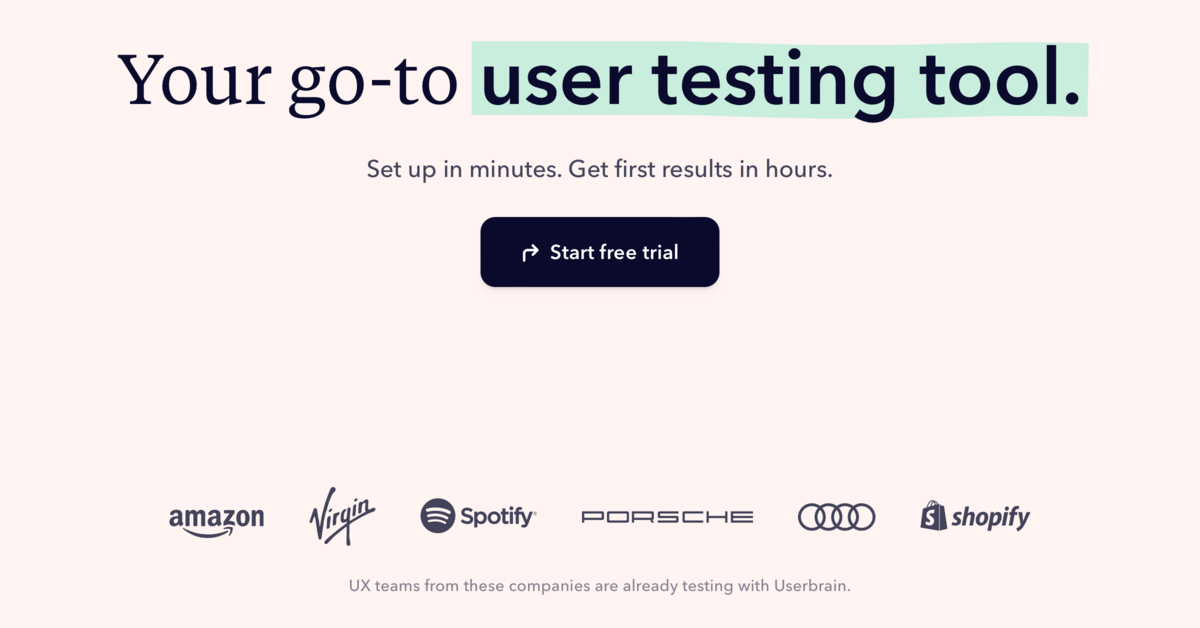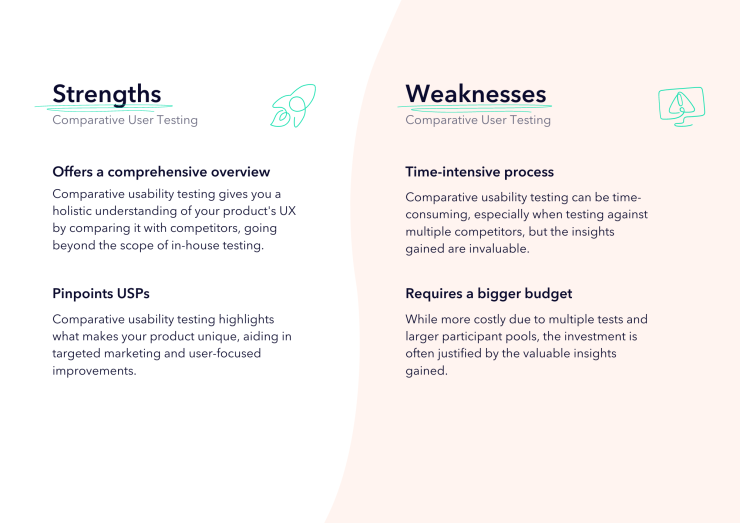Comparative Usability Testing: How to Gain a Competitive Edge
Published September 1, 2023 by Andrea in User Testing
Updated on March 5, 2024

Comparative usability testing is a research method that allows you to evaluate the user experience of your product in relation to your competitors. Unlike traditional usability testing, which focuses solely on your product, comparative testing provides a broader perspective by including competitor products in the test scenarios. This approach offers invaluable insights into what works well and what doesn’t, helping you make data-driven decisions to improve your product.
Start testing in minutes and get results within hours. Tap into our pool of 150k+ testers and watch videos of users interacting with your product on their devices. Discover what’s working for your product, and what’s not!
Start your free trialPreparing for Comparative Usability Testing
So, you’ve decided to take the plunge into the world of comparative usability testing. Exciting, isn’t it? But hold your horses; before you dive in, there’s some groundwork to cover. First off, you need to know who you’re up against. Identifying your competitors isn’t just about knowing who’s out there; it’s about understanding how they solve the same problems you’re tackling.
Goals and Metrics
Once you’ve got your competitors in your sights, it’s time to set some goals. What exactly do you want to find out? Maybe you’re curious about how your new feature stacks up against the competition, or perhaps you’re looking for an overall UX health check. Either way, having clear objectives will keep your testing focused and actionable.
Now, let’s talk metrics. You’ll want to decide on some key performance indicators (KPIs) to measure how well your product—and your competitors’ products—are doing. Common metrics like task completion rates and error rates are a good starting point.
After that, it’s time to choose a tool.
The best tools for Comparative Usability Testing
If you’re looking for advice on which user testing platform to use to carry out your tests, you’re in the right place already! Here are our top 3 tools for comparative user testing.
Userbrain 🥇 – your go-to user testing tool

- Overview: Userbrain stands out as an intuitive platform that enables you to set up usability tests swiftly and receive actionable results in just a few hours. It’s the perfect choice for UX and product teams seeking data-driven improvements.
- Key Features: The platform offers a hassle-free setup process, a diverse pool of testers, capabilities for mobile app evaluations, AI-driven insights, and transcribed feedback.
- Pricing: With plans beginning at $99 per month for a set of 3 testers and scaling up to $799 per month for a group of 30, Userbrain offers flexibility for various team sizes. A Pay-As-You-Go model is also available at $39 for each tester.
UserTesting 🥈 – the posh usability testing platform
- Overview: UserTesting is a high-end platform that excels in delivering “Customer Experience Narratives” via a video-centric approach.
- Key Features: The platform specializes in video-based customer experience narratives, tailored audience solutions, human insight management, and an open API ecosystem, all underpinned by data science and machine learning.
- Pricing: UserTesting operates on a custom pricing model, which is likely higher than that of Userbrain. Pricing information is not directly available on their website, only through a direct sales consultation.
TryMata 🥉 – the decent all-rounder
- Overview: TryMata is a versatile platform that provides a comprehensive suite of user testing and analytics tools, designed to meet the diverse needs of design teams.
- Key Features: The platform offers a range of test setup options, efficient user recruitment, extensive data collection, and collaborative analysis features.
- Pricing: Starting at $399 per month for smaller teams, TryMata also offers custom pricing solutions for larger agencies.
Data analysis and interpretation
Alright, you’ve run the tests, and you’re sitting on a goldmine of data. But where to start? First, take a step back and look at the big picture. Are there any immediate patterns or outliers that jump out at you? These initial observations can often provide quick wins or areas that need immediate attention.
Next, it’s time to get your hands dirty with some number-crunching. Dive into the quantitative data to see how your product measures up against the competition. But don’t stop there; qualitative data like user feedback and test videos can offer invaluable insights into why users behave the way they do. Tools like Userbrain even offer AI-generated insights and transcripts to make your life easier.
Leveraging data and feedback
The final step is to use the insights gained to make informed improvements to your product.
- Prioritize: Not all feedback will be equally important. Use the data to prioritize which changes will have the most significant impact on user experience.
- Action Plan: Develop a detailed action plan outlining the steps needed to implement the changes. Include timelines and responsible parties.
- Iterate: After implementing the changes, it’s essential to re-test to ensure the modifications have had the desired effect. Continuous testing platforms like Userbrain are ideal for this iterative process.
- Share Insights: The data collected can be invaluable to other departments in your organization, from marketing to product development. Make sure to share the insights broadly.
- Monitor and Adjust: Keep an eye on key metrics to ensure that the changes are having the intended effect and be prepared to make further adjustments as needed.
Strengths and weaknesses of Comparative Usability Testing
Like every user research method, there are are many strengths and weaknesses associated with comparative usability testing. Let’s focus on the main ones, starting with the strengths of this method first.
Strengths
- Offers a comprehensive view: One of the most significant advantages of comparative usability testing is that it provides a more holistic view of your product’s user experience. By comparing your product with competitors, you gain a broader perspective that goes beyond the limitations of isolated, in-house testing. This comprehensive approach allows you to understand not just how users interact with your product, but also how it stacks up against the competition.
- Pinpoints Unique Selling Propositions (USPs): Comparative usability testing can be a goldmine for identifying what sets your product apart from the competition. Whether it’s a particular feature, faster load times, or a more intuitive user interface, these unique selling points become more evident when seen in direct comparison. Knowing your USPs can guide your marketing strategies and help you focus on what truly matters to your users.
Weaknesses
- Time-intensive process: While the insights gained from comparative usability testing are invaluable, the process can be time-consuming. Setting up multiple tests, recruiting participants, and then conducting the tests across different platforms can take a considerable amount of time. This is especially true if you’re comparing your product with multiple competitors.
- Requires a bigger budget: Another downside is the potential for higher costs. Since you’re testing more than one product, you’ll need a larger pool of participants and possibly more advanced testing tools, which can add to the overall expense. However, the investment is often justified by the depth of insights you gain, which can be crucial for your product’s long-term success.

Conclusion: Ready to start Comparative Usability Testing?
Understanding your product’s strengths and weaknesses is crucial in a competitive market. Comparative usability testing offers a comprehensive way to evaluate your product and see how it stacks up against the competition. With the right tools and approach, such as Userbrain, you can gain actionable insights to improve your user experience effectively.
Next steps
Ready to dive in? Kickstart your journey with 2 free user tests at Userbrain. Start your free trial today! 🚀
Need further guidance? Don’t hesitate to schedule a one-on-one consultation with us. 👋
Back to homepage